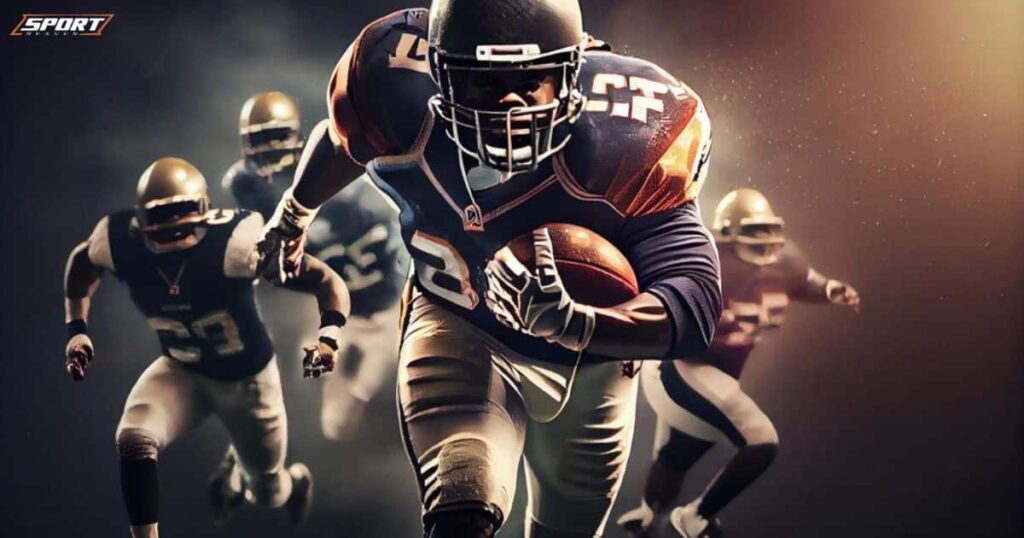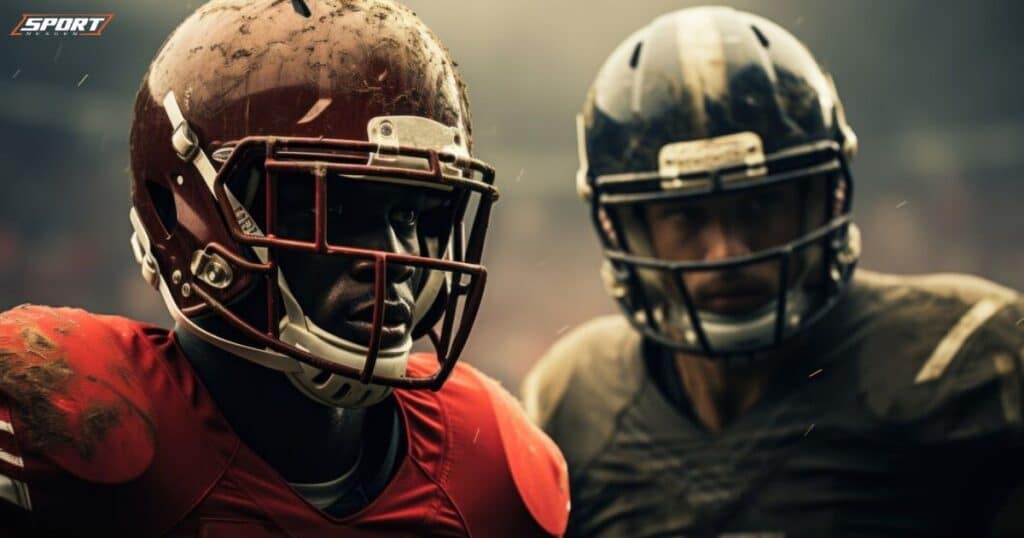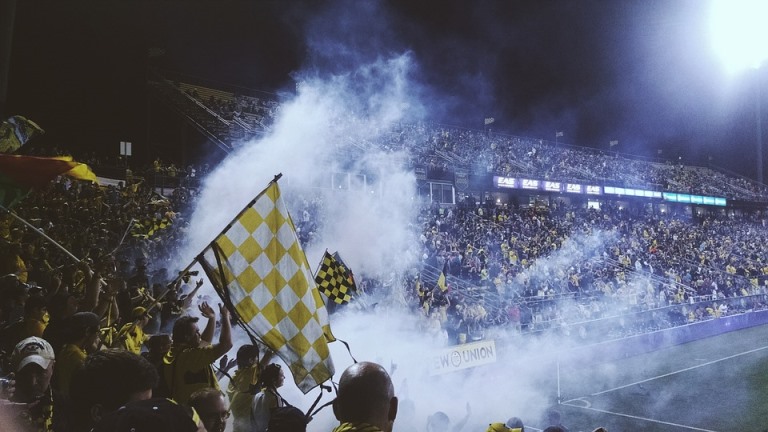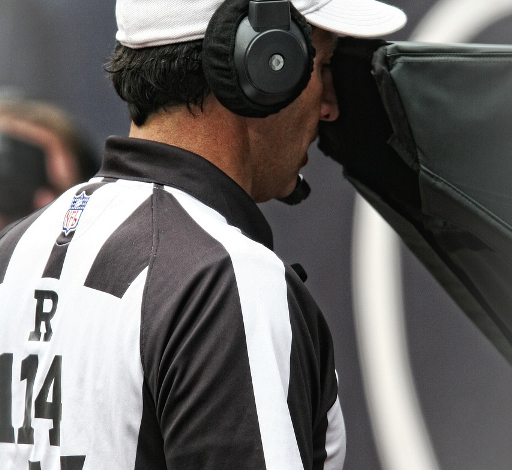
Ever seen a big hit in the backfield that stopped an offense dead in its tracks? That bone-rattling play is called a Tackle For Loss (TFL), and it’s a defensive superpower that can swing games.
A TFL is when a defender takes down the ball carrier behind the line of scrimmage, costing the offense precious yards. It’s like slamming the brakes on their drive before it even gets rolling.
While often overlooked by casual fans, TFLs are a crucial stat that defensive coaches obsess over. They showcase a unit’s ability to control the line of scrimmage and dictate the terms of engagement.
In this article, we’ll dive into what exactly a TFL is, why it’s such a game-changing play, and how elite defenses scheme to create more of them. By the end, you’ll appreciate just how pivotal those hard-hitting negative plays can be.
What does TFL mean in American Football?
A Tackle For Loss is exactly what it sounds like – when a defensive player tackles the ball carrier behind the line of scrimmage, resulting in a loss of yards for the offense. It’s a crucial stat because it showcases the defense’s ability to disrupt plays before they even start.
While sacks (when the quarterback is tackled behind the line) fall under the TFL umbrella, TFLs encompass any tackle that results in a loss of yards. It could be a running back stuffed in the backfield or a receiver taken down short of the line after catching a pass.
The Mechanics of a Tackle for Loss
So, how does a TFL actually happen? It often starts with a defensive lineman or linebacker reading the offense’s play like a book. They’ll time the snap perfectly, shed their blocker, and knife into the backfield to meet the ball carrier with a bone-jarring hit.
It takes a combination of speed, strength, and football IQ to pull off a successful TFL. Defensive players have to be able to anticipate the play, fight through blockers, and make the tackle in the congested mess of the line of scrimmage.
TFL in Football Statistics
In the stat-obsessed world of football, TFLs are a key metric for evaluating a defense’s performance. Teams and players who consistently rack up TFLs are disrupting offenses and putting them in unfavorable down-and-distance situations.
For the NFL’s top defenses, TFL numbers are closely monitored and celebrated. A high TFL total is a badge of honor, indicating a unit that’s controlling the line of scrimmage and imposing its will on the opposition.
The Impact of TFL on Game Strategy

A well-timed TFL can be an absolute game-changer. It takes an offense out of its rhythm, forces them to abandon the gameplan, and puts them in a hole they have to dig out of.
Think about it: if an offense starts a drive with a run for a loss of 3 yards, they’re immediately behind the sticks. That could lead to a long-yardage situation on 3rd down, increasing the chances of a punt or turnover.
On the flip side, a defense that’s racking up TFLs gains a huge psychological edge. They’re demoralizing the offense and feeding off the energy of those big-time plays.
TFL in Fantasy Football: A Valuable Metric
For all you fantasy football degenerates out there, TFLs are a stat you can’t ignore. In many leagues, defensive players earn points for TFLs, making them a coveted commodity.
A defensive lineman or linebacker who consistently gets into the backfield and makes tackles for loss can be a weekly difference-maker. Their TFL production could be the tiebreaker that helps you squeak out a win against your buddy’s team.
Key Players Often Involved in TFLs
While any defensive player can make a TFL, there are certain positions that tend to pile them up more frequently. Defensive linemen and linebackers, by nature of their alignment and responsibilities, are often the leaders in this category.
These are the guys who are attacking the line of scrimmage on every snap, giving them plenty of opportunities to blow up plays in the backfield. Elite defensive tackles and edge rushers can absolutely wreck game plans with their ability to penetrate and make TFLs.
How Coaches Plan to Increase TFLs
For defensive coaches, scheming up ways to create TFL opportunities is a top priority. That could mean:
- Dialing up stunts and twists to free up penetrators
- Deploying slants, angles, and line games to confuse the offense
- Focused instruction on shedding blocks and using proper footwork/hand placement
- Mixing up blitz packages to create free runners into the backfield
The goal is to put defenders in position to attack unmolested and blow up plays before they can develop.
The Historical Significance of TFLs in the NFL
Let’s take a stroll down memory lane to some of the most iconic TFL performances in NFL history:
- The 1985 Chicago Bears racked up an absurd 122 TFLs, asserting their “Monsters of the Midway” dominance.
- In 2000, Baltimore’s all-time great defense had 124 TFLs, spearheading their Super Bowl run.
- Aaron Donald’s 2018 season saw him log a mind-boggling 25 TFLs from the defensive tackle position.
Performances like these have etched certain players and defenses into the annals of legend. When you persistently live in the opposition’s backfield, you earn a spot in the history books.
Read Also: Why TfL named Lioness Overground line after England team
TFLs in College Football vs. the NFL

While TFLs are a prized stat at any level, there are some key differences in how they play out between the college ranks and the NFL:
- College offenses run more diverse schemes (option, triple-option, etc.), opening up more TFL chances
- Offensive line play is generally less polished in college, making penetration easier for defenses
- Rules regarding blocking differ slightly between college and pro games
That said, a college defensive stud who piles up TFLs is sure to get NFL scouts’ attention. It’s a strong indicator of a player’s ability to be disruptive at the next level.
Looking Ahead: The Future of TFLs in Football Evolution
As offensive and defensive schemes continue to evolve, the philosophy around TFLs and how to create them will shift as well. Potential rule changes that alter blocking rules or promote offensive scoring could impact their importance.
But one thing is certain – as long as the game is played, there will be an emphasis on penetrating defenders who can make tackles for loss. It’s an integral part of winning the line of scrimmage battle that decides so many football games.
Read Also: What is a Reception in Football?
Getting Vertical with TFL Leaders
No discussion of TFLs would be complete without highlighting some of the players who make a living in the offensive backfield:
- Aaron Donald (DT, Los Angeles Rams) – An interior wrecking ball who seems to have mastered quantum physics to constantly beat double teams.
- T.J. Watt (EDGE, Pittsburgh Steelers) – Combines elite athleticism and fundamentals to knife through gaps and ruin plays.
- Bobby Wagner (LB, Seattle Seahawks) – An absolute thumper who has a nose for the ball carrier and loves putting them in the dirt.
These are the type of game-wreckers that have made a career out of compiling TFLs and headaches for opposing offenses.
TFLs in the Spotlight
When you look at some of the biggest, most memorable plays in football history, many were TFLs that swung momentum:
- The “Butt Fumble” – When Mark Sanchez ran directly into the backside of his lineman, coughing up the ball for a TFL and safety. An all-time blooper.
- “The Hit” – When Sean Taylor absolutely de-cleated Brian Moorman with a devastating TFL on a fake punt attempt.
- “The Stop” – When Baltimore’s immense goal line stand, punctuated by a TFL, denied Seattle a go-ahead TD in Super Bowl XLVII.
These are the type of jaw-dropping, iconic TFL moments that live on in football lore for years to come.
So the next time you see a defensive player knife into the backfield to stuff a runner for a loss, take a moment to appreciate it. That TFL could end up being a pivotal play that decides the outcome of the game, fantasy matchup or even a championship. It’s a crucial statistic that deserves its due respect.
Celebrating the Unsung Heroes of TFL Production

While the superstars tend to grab the headlines, there are plenty of under-the-radar players who are absolute monsters when it comes to racking up TFLs. These are the grinders who may not put up gaudy sack numbers but constantly live in the opposition’s backfield.
Guys like Dre’Mont Jones (DT, Denver Broncos), Uchenna Nwosu (LB, Seattle Seahawks), and Jonathan Greenard (EDGE, Houston Texans) were among the TFL leaders last season. While not household names, their knack for penetration and making stops behind the line was a huge part of their teams’ defensive success.
The Impact of Analytics on TFL Strategy
In today’s hyper-analytical NFL landscape, you can bet teams are diving deep into the advanced metrics surrounding TFLs. Coaches and front offices are looking at:
- Charting which offensive formations, plays, and tendencies most frequently lead to TFLs
- Identifying the physical and athletic traits that project TFL production at each defensive position
- Tracking individual offensive linemen’s rates of allowing or preventing TFLs
This granular data helps shape game plans, roster construction, and coaching philosophies – all in an effort to tilt those all-important TFL numbers in their favor.
Mastering the Art of the Pash Rush to Generate TFLs
For defenses focused on generating TFLs, having an elite pass rush is key. The ability to collapse the pocket forces offenses into quick, timing-based throws or forces the quarterback to tuck and try to scramble.
In both scenarios, the defense has a chance to blow up the play for a TFL by either corralling the QB as he tries to escape or rallying to stop the back after a shortened drop.
Teams loaded with talented pass rushers like Myles Garrett, Nick Bosa, and Maxx Crosby consistently rank near the top of the league in TFLs for this very reason. The constant pressure they provide sets up ample tackle for loss opportunities.
Developing a “Tackle for Loss” Mentality
For players, racking up TFLs requires a particular mindset of aggressiveness and effort. It’s not just about being physically talented – they have to persistently fight through blocks, chase plays from the backside, and make something happen when it seems like there’s nothing there.
That tackle for loss mentality is something coaches have to instill through drills, film study, motivation, and constantly preaching effort. It’s getting defensive players to sacrifice their body and play with a relentless motor every single snap.
When you have 11 guys on defense playing with that level of intensity and abandon, consistently attacking to force negative plays, it’s a nightmare scenario for opposing offenses.
Read Also: What is Edge in Football: The Evolution and Impact of NFL Edge Rushers
TFLs and The Rise of the “Positionless” Defender

One trend that’s aided the proliferation of TFLs in recent years is the advent of the positionless defender – hybrid players who can line up anywhere on the field and create chaos.
Guys like Derwin James (LAC), Jamal Adams (SEA) and Kyle Dugger (NE) have the size, athleticism, and versatility to walk up and make plays behind the line of scrimmage one snap, then drop back into coverage the next. Their positional flexibility gives offenses constant fits in terms of identifying threats and adjusting protections.
As defenses get more multiple and creative with their personnel usage, offenses have to stay on their toes. Otherwise, they could get hit with a back-breaking TFL from an unexpected source.
TFLs and The Debate Around Offensive Line Technique
In the ongoing tug-of-war between offensive and defensive line play, the acceptable techniques and allowances for linemen are always a hot-button issue. And it directly relates to the ability to prevent (or create) TFLs.
Rule changes or points of emphasis that open up or restrict certain blocking tactics can drastically impact angles for penetration and chances for negative plays. For example, rules limiting cut blocks could give penetrating linemen more clear paths into the backfield.
As the league continually evaluates the rulebook surrounding line play, you can expect both offensive and defensive coaches to heavily lobby for adjustments that give their side the upper hand in the battle for TFL supremacy.
FAQ’s
What does TFL mean in football stats?
TFL stands for Tackle For Loss. It refers to when a defensive player tackles the ball carrier behind the line of scrimmage, resulting in a loss of yards for the offense.
Do TFL count as tackles?
Yes, TFLs are counted as tackles in football stats along with regular tackles made past the line of scrimmage.
What does TFL stand for in the NFL?
In the NFL, TFL stands for Tackle For Loss.
What is TFL in fantasy football?
In fantasy football, TFLs by defensive players often earn your team points, making players who rack up lots of TFLs very valuable.
How do TFL zones work?
There’s no specific “TFL zone” – it refers to any tackle made behind the offensive line’s line of scrimmage that results in a loss of yards.
Does a sack count as TFL?
Yes, any sack where the quarterback is tackled behind the line of scrimmage counts as a Tackle For Loss (TFL) in the stats.
Final Words
Tackles For Loss are the ultimate momentum-shifters in football. When a defender crashes into the backfield to stuff the ball carrier for a loss, it puts the offense in a major hole. These disruptive plays are analytical gold for teams – they show a defense is flat-out dominating the line of scrimmage.
From game-planning to fantasy implications, TFLs are a vital stat that can’t be ignored. Elite players like Aaron Donald make careers out of living in the backfield. So next time you see an offensive play blown up behind the line, appreciate that game-changing TFL for the defensive brilliance it represents.



